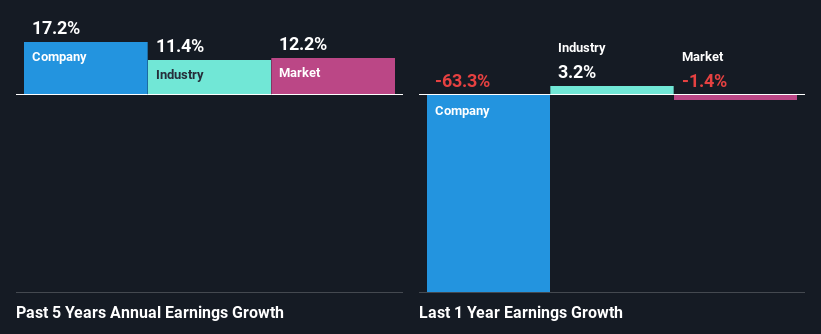Steppe Cement Ltd.'s (LON:STCM) Fundamentals Look Pretty Strong: Could The Market Be Wrong About The Stock?
Steppe Cement (LON:STCM) has had a rough three months with its share price down 17%. However, a closer look at its sound financials might cause you to think again. Given that fundamentals usually drive long-term market outcomes, the company is worth looking at. Specifically, we decided to study Steppe Cement's ROE in this article.
Return on equity or ROE is a key measure used to assess how efficiently a company's management is utilizing the company's capital. In simpler terms, it measures the profitability of a company in relation to shareholder's equity.
See our latest analysis for Steppe Cement
How Do You Calculate Return On Equity?
ROE can be calculated by using the formula:
Return on Equity = Net Profit (from continuing operations) ÷ Shareholders' Equity
So, based on the above formula, the ROE for Steppe Cement is:
12% = US$7.7m ÷ US$65m (Based on the trailing twelve months to June 2023).
The 'return' is the yearly profit. That means that for every £1 worth of shareholders' equity, the company generated £0.12 in profit.
What Has ROE Got To Do With Earnings Growth?
Thus far, we have learned that ROE measures how efficiently a company is generating its profits. Depending on how much of these profits the company reinvests or "retains", and how effectively it does so, we are then able to assess a company’s earnings growth potential. Assuming all else is equal, companies that have both a higher return on equity and higher profit retention are usually the ones that have a higher growth rate when compared to companies that don't have the same features.
Steppe Cement's Earnings Growth And 12% ROE
At first glance, Steppe Cement seems to have a decent ROE. Even when compared to the industry average of 11% the company's ROE looks quite decent. Consequently, this likely laid the ground for the decent growth of 17% seen over the past five years by Steppe Cement.
Next, on comparing with the industry net income growth, we found that Steppe Cement's growth is quite high when compared to the industry average growth of 11% in the same period, which is great to see.

Earnings growth is an important metric to consider when valuing a stock. What investors need to determine next is if the expected earnings growth, or the lack of it, is already built into the share price. This then helps them determine if the stock is placed for a bright or bleak future. One good indicator of expected earnings growth is the P/E ratio which determines the price the market is willing to pay for a stock based on its earnings prospects. So, you may want to check if Steppe Cement is trading on a high P/E or a low P/E, relative to its industry.
Is Steppe Cement Making Efficient Use Of Its Profits?
While Steppe Cement has a three-year median payout ratio of 68% (which means it retains 32% of profits), the company has still seen a fair bit of earnings growth in the past, meaning that its high payout ratio hasn't hampered its ability to grow.
Besides, Steppe Cement has been paying dividends over a period of nine years. This shows that the company is committed to sharing profits with its shareholders.
Summary
On the whole, we feel that Steppe Cement's performance has been quite good. Especially the high ROE, Which has contributed to the impressive growth seen in earnings. Despite the company reinvesting only a small portion of its profits, it still has managed to grow its earnings so that is appreciable. Up till now, we've only made a short study of the company's growth data. So it may be worth checking this free detailed graph of Steppe Cement's past earnings, as well as revenue and cash flows to get a deeper insight into the company's performance.
Have feedback on this article? Concerned about the content? Get in touch with us directly. Alternatively, email editorial-team (at) simplywallst.com.
This article by Simply Wall St is general in nature. We provide commentary based on historical data and analyst forecasts only using an unbiased methodology and our articles are not intended to be financial advice. It does not constitute a recommendation to buy or sell any stock, and does not take account of your objectives, or your financial situation. We aim to bring you long-term focused analysis driven by fundamental data. Note that our analysis may not factor in the latest price-sensitive company announcements or qualitative material. Simply Wall St has no position in any stocks mentioned.
